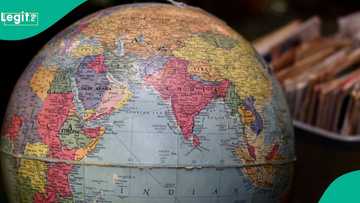Top 10 Most Populous Countries in the World 2025, Nigeria Ranked 6
- India has overtaken China in the rank of the world's most populous nations, with over 1.46 billion people as of 2025
- In 2022, the global population reached 8 billion, as population growth rates are projected to decline sharply in 2025
- Legit.ng presents the list of the world's most populous nations, with Nigeria securing the 6th spot in 2025
Legit.ng journalist Esther Odili has over two years of experience covering political parties and movements.
As of 2025, the world's population stands at almost 8.2 billion people and is expected to reach around 10.3 billion people in the 2080s, when it will then go into decline.

Source: UGC
India secured the first spot in terms of population size in 2025, with over 1.46 billion people, according to recent data from the World Population Review (WPR). China follows closely behind in second place, with just over 1.42 billion people.
Based on the projections by WPR, India is anticipated to become the world's most populous country after the year 2030. This growth is expected to continue for several decades, with estimates suggesting that India's population will reach its peak at a staggering 1.65 billion individuals around the year 2060.
The current world population is around 8.2 billion, with an increase estimated at around 70 million people per year. The world population is expected to reach 9 billion by 2037.
Without further ado, Legit.ng compiled a list of top 10 countries with the most population at the start of 2025, according to Worldometer, a reference website that provides counters and real-time statistics:
1. India - 1,463,865,525
India has surpassed china to emerge as the world's most populous country with a population of 1,463,865,525.
Its population grows annually at about 0.89%. India’s demographic makeup is diverse, with a median age of around 28.8 years, and more than 37% live in urban areas.
2. China - 1,416,096,094
China took the second spot as most populous country, with approximately 1.42 billion people in 2025.
Its population has slightly decreased by 0.23%, a sign of demographic shifts. The country has a high population density of 151 people per km² and a median age of 40.1 years. Most Chinese live in urban areas, which make up 67.5% of the population. China faces challenges related to ageing populations and lower birth rates.

Source: UGC
3. United States - 347,275,807
United States now takes the third place with around 342 million residents. While far behind India and China, the U.S. remains a major economic and cultural force globally.
With a modest annual growth rate of 0.54%, its population growth is driven by migration and natural increase. The median age is 38.5 years, with urban areas housing over 82% of Americans.
4. Indonesia - 285,721,236
Indonesia hold the fourth position with a population roughly about 286 million in 2025, growing at about 0.79% annually.
Its land area of 1.81 million km² makes it the world's largest island nation. The median age is around 30.4 years, with nearly 60% residing in urban areas. Population growth remains strong with 59.6%, driven by high fertility rates of 2.1 children per woman.
5. Pakistan - 255,219,554
In 2025, Pakistan's population is an estimated 255 million, experiencing rapid growth at about 1.57% annually.
Based n estimates, it covers roughly 770,880 km², with a density of 331 people per km². The median age is around 20.6 years, indicating a very young population. Urbanisation is moderate, with about 34.4% in cities. Pakistan faces challenges related to overpopulation, poverty, and infrastructure.
6. Nigeria - 237,527,782
Nigeria now takes sixth place with approximately 238 million inhabitants in 2025, growing at approximately 2.08% annually.
Its land area of 910,770 km² results in a density of 261 people per km². Nigeria has a median age of about 18.1 years, with more than half living in urban areas. The country’s population growth is driven by high birth rates (4.3 children per woman).
Nigeria’s economy is diverse, with agriculture, oil, and telecommunications playing key roles. Nigeria's population boom could fuel its rise or overwhelm its resources if not well-managed.
7. Brazil - 212,812,405
Brazil’s population is estimated at 213 million in 2025, with a growth rate of 0.38%. Its land area spans over 8.36 million km², making it the largest country in South America. The median age is 34.8 years, with urbanisation high at 91.4%. Brazil’s population growth has slowed considerably, leading to ageing demographics.
8. Bangladesh - 175,686,899
Bangladesh’s population reached about 176 million in 2025, growing at 1.22%. Its land area is 130,170 km², resulting in a very high density of 1,350 people per km². The median age is around 26 years, with over 42% of residents living in urban areas.
9. Russia - 143,997,393
Russia’s population will be approximately 144 million in 2025,but unlike others in the chart, it is experiencing a decline of 0.57%.
Covering 16.4 million km², Russia has a low population density of 9 people per km². The median age is 40.3 years, reflecting an ageing population. Urbanisation is high, with 75% living in cities.
Russia faces demographic issues such as low birth rates and increased mortality.
10. Ethiopia - 135,472,051
On the top 10 lost is Ethiopia securing the last spot with 135 million people in 2025, and a high growth rate of 2.58%. Its land area of 1 million km² creates a density of 135 people per km². The median age is around 19.1 years, with only 22.5% living in urban areas.
Ethiopia’s fertility rate is about 3.8 children per woman. Over recent decades, the country has seen rapid population increases, making it one of Africa’s fastest-growing nations.
Read related articles here:
- Top 10 strongest countries in the world by military strength
- List of world's happiest countries released, Nigeria in strong position
- World Happiness report: See where Nigeria ranks in 2018
List of happiest countries in Africa in 2025
Similarly, Legit.ng reported that While African nations often face formidable social and economic challenges, several countries have steadily climbed the happiness rankings, offering a fresh perspective on well-being across the continent.
The 2025 World Happiness Report has spotlighted the top African nations where citizens report the highest life satisfaction, based on a rigorous analysis of six key factors: GDP per capita, social support, healthy life expectancy, freedom, generosity, and perceptions of corruption.
Source: Legit.ng







